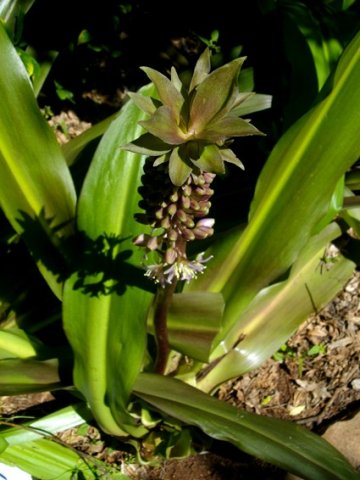Eucomis

Author: Ivan Lätti
Photographer: Thabo Maphisa
Eucomis is a genus of deciduous, bulbous perennials in the Hyacinthaceae family. The globose to ovoid bulbs are mostly large in membranous tunics, becoming dark with numerous roots growing from the base.
There was a formal name change decision taken in 2016 by the APG (Angiosperm Phylogeny Group) IV, moving Hyacinthaceae entirely into Asparagaceae as the subfamily Scilloideae. This will probably cascade through the botanical literature in due course, meaning that Hyacinthaceae is officially no longer recognized as a separate family. Later South African books do not necessarily show this change yet, for reasons including that it is not legally binding and the people in the plants community are allowed to take their time in absorbing changes, bigger ones more slowly. And, of course, some recent decisions may be expected to be reversed or modified still, as all the evidence supporting them may not yet have fully percolated through the system.
Optional earlier classifications may thus be continued, preventing sudden changes from causing regional confusion among users. Allowing taxonomic conservatism to adapt, should be regarded as temporary, for in the end all recognized plant families should be monophyletic, meaning that they confirm descent from a most recent common ancestor and include all descendants. Formally given scientific plant names are continually brought up to date, in accordance with this principle. This website, mainly serving amateurs, usually follows the SANBI Red List Site in its timing of reflected changes.
The few to many strap-shaped or obovate leaves of Eucomis plants are prostrate or ascend from the base. The leaves grow concurrently with the inflorescence. Lower leaf surfaces are in their lower parts often suffused, barred or spotted purple. The blades are smooth and hairless, channelled near the base.
The inflorescence is a dense, many-flowered raceme, crowned with a coma of leafy bracts that are usually sterile. The peduncle is sturdy and cylindrical to club-shaped. The bracts among the flowers are smaller than those of the coma.
The bisexual flowers grow on pedicels of variable length. They have six persistent tepals in two whorls of three, fused at the base but spreading at their tips. The tepals are oblong to slightly lance-shaped. Flower colour is white, cream, greenish or purplish red. In some species or on some plants the flowers are strongly scented.
Six stamens emerge from near the segment bases. Their filaments are fused near the base, forming a shallow cup. The superior ovary is globose to obovoid, comprising three locules and producing nectar at its top.
The fruit is a three-segmented capsule. The seeds are globose to ovoid, dark and hard.
The about eleven species of Eucomis all grow in southern to central Africa, from Agulhas (Eucomis regia) to as far as Malawi, usually in any but the arid parts of the region.
The plants occur in grassland, forests, swamps and along rivers from the coast to montane areas at high elevations. They grow solitary or form colonies and sometimes hybridise naturally.
The plant in picture was seen in the Walter Sisulu National Botanical Garden, flowering at the end of January. It resembles the Sparkling Burgundy variety of E. comosa (Pooley, et al, 2025; Euston-Brown and Kruger, 2023; Leistner, (Ed.), 2000; Manning, 2007; iNaturalist; www.sarahraven.com; http://redlist.sabi.org).

